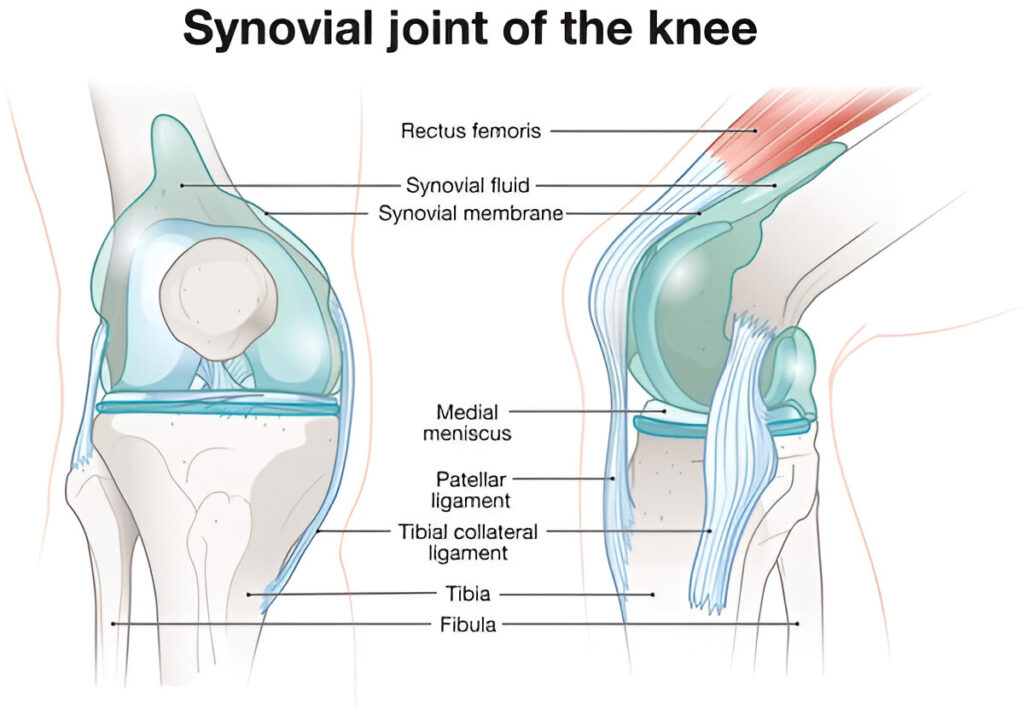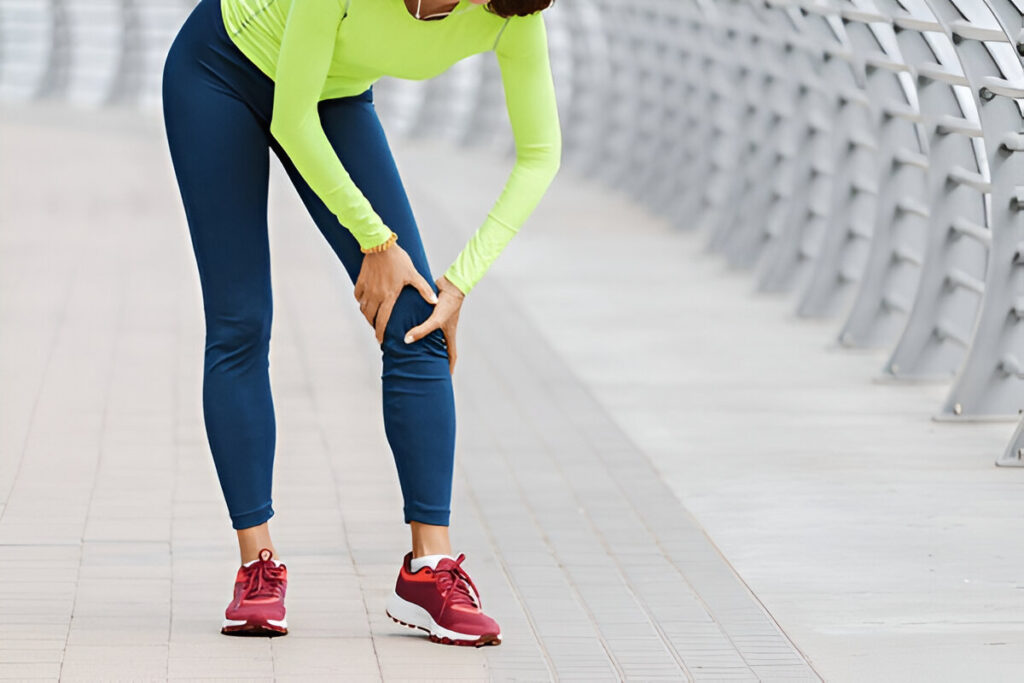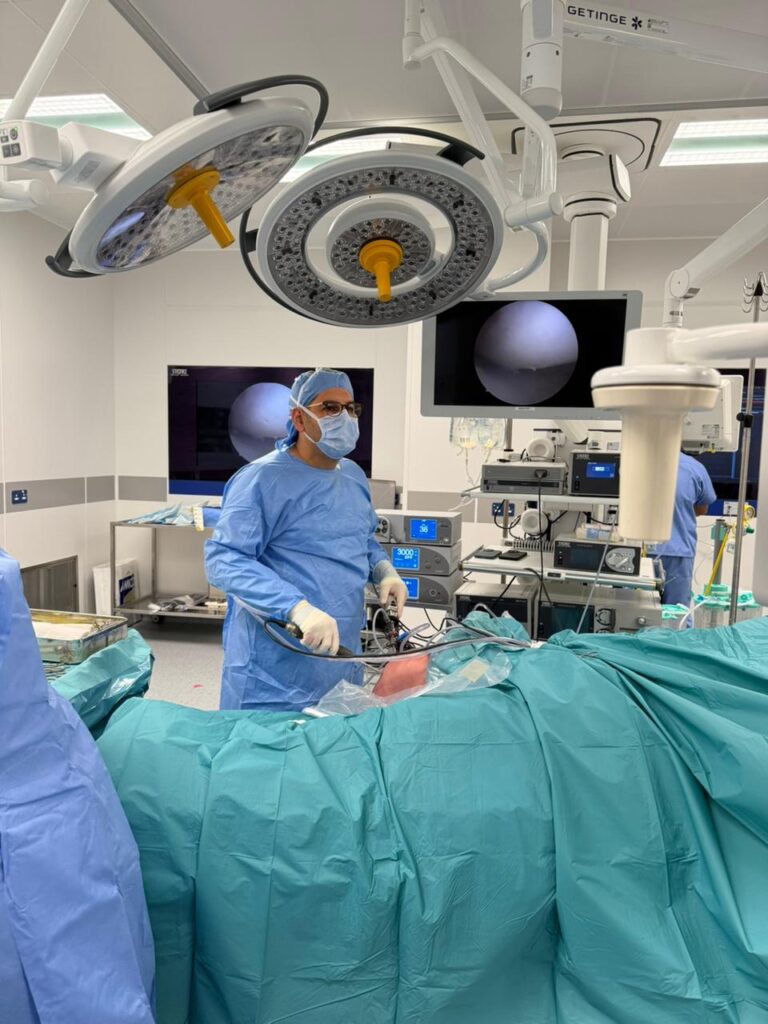Is it dangerous to have fluid on the knee?
Fluid on the knee or water on the knee or knee effusion, can feel alarming. That unsettling swelling, stiffness, or discomfort might have you wondering: Is it dangerous to have fluid on the knee?
While it can signal an underlying issue, it’s often treatable with the right care.
Dr. Hesham Al-Khateeb, Dubai’s leading orthopedic surgeon, specializes in treating fluid in the knee with cutting-edge techniques, ensuring you regain mobility and live pain-free.
We’ll explore what causes fluid on the knee, whether it’s dangerous, and how to effectively remove it. From causes to treatments, we’ll cover it all so you’re empowered with knowledge and know when to seek expert care from Dr. Hesham.

What is fluid on the knee? Understanding the basics
Water on the knee is a common term for knee effusion, where excess fluid builds up in or around the knee joint. This fluid, often synovial fluid, acts as a lubricant for the joint but can accumulate due to injury, inflammation, or other conditions, leading to swelling and discomfort.
Snippet
- Medical term: Knee effusion
- Appearance: Swelling or puffiness around the knee
- Sensation: Stiffness, pain, or a “full” feeling
Fluid in the knee isn’t always dangerous, but it’s a sign your body is reacting to something, whether it’s an injury, arthritis, or infection. Ignoring it could worsen the underlying issue, so understanding what is water on the knee and its causes is key.
Is it dangerous to have fluid on the knee?
The short answer: It depends. Fluid on the knee itself isn’t inherently dangerous, but it’s often a symptom of an underlying condition that needs attention. Left untreated, some causes of fluid in the knee can lead to complications like joint damage or infection. Here’s how to gauge the severity:
When fluid on the knee is mild
- Causes: Minor injuries, overuse, or early-stage arthritis
- Symptoms: Mild swelling, slight stiffness, manageable discomfort
- Risk: Low, but monitoring is essential to prevent worsening
When it could be serious
- Causes: Infections (septic arthritis), severe injuries (like ACL tears), or chronic conditions (rheumatoid arthritis)
- Symptoms: Intense pain, fever, redness, or inability to move the knee
- Risk: High—seek immediate medical care to prevent joint damage or systemic infection
Pro Tip: If your knee feels warm, looks red, or you have a fever alongside fluid around the knee, don’t wait. Get prompt help for a thorough evaluation and treatment plan. |
What causes fluid on the knee? Unpacking the triggers
Understanding what causes water on the knee is the first step to effective treatment. Fluid buildup in knee can stem from various sources, ranging from injuries to medical conditions. Here are the most common culprits:
1. Injuries
- Meniscus tears: A tear in the knee’s cartilage can cause inflammation and fluid in the knee.
- Ligament injuries: ACL or MCL tears often lead to swelling and knee fluid.
- Fractures: Bone breaks around the knee can trigger fluid buildup.
2. Arthritis
- Osteoarthritis: Wear-and-tear arthritis causes joint inflammation, leading to fluid on the knee.

- Rheumatoid arthritis: An autoimmune condition that attacks joints, causing chronic fluid around the knee.
- Gout: Uric acid crystals in the knee can cause painful swelling and water in the knee.
3. Infections
- Septic arthritis: A bacterial infection in the joint causes rapid fluid buildup in knee, often with fever and severe pain.
- Bursitis: Inflammation of the bursa (a fluid-filled cushion) can mimic fluid on the knee.
4. Other Causes
- Overuse: Repetitive activities like running or jumping can irritate the knee, causing water on the knee.
- Cysts: A Baker’s cyst behind the knee can cause localized fluid in the knee.
- Tumors: Rare, but benign or malignant growths can lead to knee fluid.
Studies in the Journal of Orthopaedic & Sports Physical Therapy show that trauma-related fluid on the knee accounts for most cases in active adultsapy.
Symptoms of fluid on the knee: What to look out for
Recognizing the signs of fluid on the knee helps you act fast. Common symptoms include:
- Swelling: The knee looks puffy or feels “larger” than usual.
- Stiffness: Difficulty bending or straightening the knee.
- Pain: Ranges from mild discomfort to sharp pain, especially during movement.
- Warmth or redness: May indicate infection or inflammation.
- Reduced mobility: Trouble walking or bearing weight on the knee.
If you’re wondering what is water on the knee doing to your daily life, these symptoms can make activities like climbing stairs, praying, or playing with kids challenging. That’s where Dr. Hesham’s expertise comes in—he designs treatment plans to restore your freedom of movement.
How to get fluid out of knee? Exploring treatment options
The fastest way to remove fluid on the knee depends on the cause and severity, and whether conservative or surgical options are needed. Dr. Hesham Al-Khateeb tailors fluid on knee treatment to your unique condition, using advanced techniques for optimal results. Here’s a look at the options available:
1. Conservative treatments
These are often the first line of defense for mild to moderate fluid in the knee:
- RICE method:
- Rest: Avoid activities that stress the knee.
- Ice: Apply cold packs for 15-20 minutes to reduce swelling.
- Compression: Use a knee wrap to support and minimize fluid buildup in the knee.
- Elevation: Keep your leg raised above heart level to drain knee fluid.
- Medications:
- Anti-inflammatory drugs (e.g., ibuprofen) can reduce pain and fluid on the knee.
- Antibiotics for infection-related water in the knee.
- Physical therapy:
- Exercises to strengthen muscles around the knee and improve mobility.
- Dr. Hesham’s team designs custom rehab plans to speed up recovery.
2. Medical procedures
For persistent or severe fluid on the knee, Dr. Hesham may recommend:
- Aspiration (draining fluid):
- A needle is used to remove excess fluid from the knee under local anesthesia.
- Provides immediate relief from swelling and discomfort.
- Note: Draining water on the knee yourself is dangerous and can lead to infection—always seek a professional like Dr. Hesham.
- Corticosteroid injections:
- Reduces inflammation and fluid in the knee for arthritis-related cases.
- Offers relief for weeks to months.
- Hyaluronic acid injections:
- Lubricates the joint, easing pain and reducing knee fluid in osteoarthritis.
3. Surgical interventions
When fluid on the knee stems from structural damage, surgery may be needed:
- Arthroscopy:
- A minimally invasive procedure using a tiny camera to repair meniscus tears or remove debris causing fluid buildup in the knee.
- Dr. Hesham uses state-of-the-art robotics for precision and faster recovery.
- Knee replacement:
- For severe arthritis causing chronic fluid in the knee, Dr. Hesham offers custom-made implants for natural movement and full mobility.
- Ideal for patients seeking long-term relief and a return to active lifestyles.
- Ligament reconstruction:
- Repair torn ligaments (e.g., ACL) to stabilize the knee and prevent recurrent water on the knee.
Why Choose Dr. Hesham?
With his expertise in robotics and personalized implants, Dr. Hesham ensures fluid on knee treatment is precise, effective, and tailored to your needs, helping you return to prayer, play, and everything in between.
What is the fastest way to get rid of fluid on the knee?
Speeding up recovery from fluid on the knee requires a combination of proper diagnosis, targeted treatment, and expert care. Here’s how Dr. Hesham accelerates your healing:
At-home tips (under medical guidance)
- Stay Consistent with RICE: Regular icing and elevation can reduce fluid around the knee within days.
- Avoid Overuse: Resting the knee prevents further irritation and knee fluid buildup.
- Use Supportive Gear: Knee braces can stabilize the joint and reduce fluid in the knee.
Professional care
- Early diagnosis: Dr. Hesham uses advanced imaging (MRI, ultrasound) to pinpoint what causes fluid on the knee, ensuring the right treatment plan.
- Minimally invasive options: Aspiration or arthroscopy offers quick relief from water in the knee with minimal downtime.
- Custom rehab plans: Physical therapy tailored to your condition speeds up recovery and prevents recurrent fluid on the knee.
- Healing Timeline: Mild cases of fluid in the knee may improve in 1-2 weeks with conservative care, while severe cases (e.g., infections or injuries) may require weeks to months, depending on treatment.

Preventing fluid on the knee: Tips for long-term joint health
Dr. Hesham Al-Khateeb is Dubai’s top orthopedic surgeon, renowned for his expertise in knee conditions, including fluid on the knee. Here’s why patients choose him:
- Advanced techniques: From robotics to custom implants, Dr. Hesham uses cutting-edge technology for precise fluid on knee treatment.
- Personalized care: Every patient receives a bespoke treatment plan tailored to their lifestyle and needs.
- Rapid recovery focus: Minimally invasive procedures and custom plans ensure you’re back to your routine quickly.
- Holistic approach: Dr. Hesham addresses what causes fluid on the knee while promoting long-term joint health.
Whether you’re dealing with water in the knee from an injury or arthritis, Dr. Hesham’s expertise ensures optimal outcomes and a return to full mobility.
Why trust Dr. Hesham Al-Khateeb for fluid on the knee?
Once you’ve addressed the fluid on the knee, preventing recurrence is crucial. Dr. Hesham’s holistic approach emphasizes joint health to keep water in the knee at bay:
- Stay active: Low-impact exercises like swimming or cycling strengthen the knee without stress.
- Maintain a healthy weight: Excess weight puts pressure on the knee, increasing the risk of fluid buildup in the knee.
- Warm up properly: Stretching before activities reduces the risk of injuries, causing knee fluid.
- Monitor symptoms: Early intervention for pain or swelling prevents worsening of fluid on the knee.
- Regular checkups: Dr. Hesham offers comprehensive evaluations to catch issues before they lead to water on the knee.
Fun Fact: Strengthening your quadriceps can reduce the risk of fluid in the knee by up to 30%, according to research in the Journal of Sports Medicine.
Consult Dr. Hesham and get the help you need
Don’t let fluid on the knee hold you back from life’s moments—whether it’s playing with your kids, staying active, or simply moving without pain.
Dr. Hesham Al-Khateeb combines world-class expertise with compassionate care to treat fluid in the knee and restore your quality of life.
With advanced diagnostics, personalized treatments, and a focus on rapid recovery, he’s your trusted partner in overcoming water on the knee.
Take the First Step Today: Book your appointment with Dr. Hesham and start your journey to a pain-free, active life!
FAQs
Treatment depends on the cause but often includes rest, ice, compression, elevation (RICE), medications, physical therapy, or aspiration by a doctor. Addressing the underlying issue is key.
A medical professional can remove fluid via arthrocentesis (joint aspiration), a procedure in which a needle is used to drain the excess fluid.
Water on the knee is commonly caused by injuries (ligament/meniscus tears, fractures), inflammatory conditions (arthritis, gout), or sometimes infection.
Water in the knee refers to the accumulation of excess fluid within the knee joint, also medically known as knee effusion. It’s often a symptom of an underlying issue.
Absolutely NOT safe.
Attempting draining water on the knee yourself can lead to severe infection, nerve damage, and further injury. Always seek professional medical help.
Common fluid on knee causes include acute injuries (sprains, tears), chronic conditions like osteoarthritis or rheumatoid arthritis, gout, and sometimes infections.

